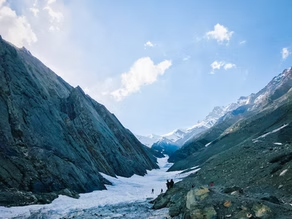Spiti Valley: A Place Where the Gods Live

Spiti valley, a cold desert mountain valley, is located in the north- eastern parts of Himachal Pradesh. The word “Spiti” means “the middle land” and thus Spiti is very aptly named as it is situated between India and Tibet. Spiti has beautiful landscapes, picturesque valleys and peaceful villages with a low population. Photo by Anisha Tulika (Unsplash) Spiti has a huge influence of Buddhism due to its geographic location and hence, religion plays a very important role in the day-to-day life of the people living in Spiti. Spiti, an untamed land of solitude and spiritualism, houses a lot of monasteries and temples. The soothing sounds of God praising chants in both temples and monasteries gives one a sense of relief or the “sukoon” that everyone misses in their lives. So, if you want to experience that sukoon and see the serene architecture situated in and around the Spiti Valley, read on the following list of top religious places of Spiti Valley: Trilokinath Temple Key Monastery Tabo Monastery Mrikula Mata Kardang Monastery Giu Mummy Tangyud Monastery Gandhola Monastery Tayul Monastery Kungri Monastery 1. Trilokinath Temple Photo By Government of Himachal Pradesh A temple visited equally by Hindus and Buddhists, the Trilokinath Temple is situated in the Udaipur sub- division of Lahual District. In ancient times, the temple was popularly known as Tunda Vihar. While Hindus consider the temple to belong to Lord Shiva, it is believed that the Buddhists consider the temple to belong to the deity “Arya Avalokiteshwar or Garja Fagspa. This holy temple is very sacred as it is believed to be the Teerath Sthal next only to Kailash and Mansarover and hence is a very important shrine. Though a lot of stories are told about the history of the temple, one of the most commonly heard stories is: Back in the 10th century, seven people used to come out of the lake (presently known as Hinsa Nala) and drink the milk of the cows grazing nearby. One day, a cow herder boy saw this and took one of them to his village. Upon reaching the village, the person turned into marble and since then, a temple has been built around the marble deity. The Hinsa Nala is believed to have milky white water which remains the same throughout the year even with changing weather. Best time to visit: The best time to experience the beauty of the Trilokinath Temple is from April- October. 2. Key Monastery Photo By Yash Raut (Unsplash) Also known as Kye Gompa, it is the largest monastery in Spiti Valley and houses about 250 monks who reside in the monastery throughout the year. It is situated 12km north of Kaza. Founded by Atisha’s (a famous teacher) pupil, Dromtön in the 11th century, but was destroyed multiple times by Mongols, in wars between Ladakh and Kullu, by the Dogra army under Ghulam Khan and Rahim Khan, Sikhs, fire and earthquake throughout history. The monastery has a collection of ancient books and murals which include images of Lord Buddha. The walls of the monastery are covered with paintings, which is a result of Chinese influence. Best time to visit: The best time to visit Kye Monastery is in the summer season, during the months of April- October. 3. Tabo Monastery Photo By Nomad Bikers Protected by the Archaeological Survey of India as a national historical treasure of India, Tabo Monastery was built in 996 AD by the Royal Lama Yeshe- O. It is also known as the daughter monastery of the Tholing Monastery in Ngari (western Tibet). Tabo is the oldest earthen Buddhist monastery in the Himalayan region and is also referred to as the Ajanta of the Himalayas. The temple complex constitutes Stupas, Fittings, Older Temples, Newer Temples and a Main Temple. Tsug La Khang or the main temple, includes an assembly hall, an entry hall, and a recessed area which has a shrine area. The older temples constitute the Mahakala Vajra Bhairava Temple, the White Temple, the Large Temple of Dormton and the Chamber of Picture Treasures. The newer temples include the Golden Temple, the Bodhisattva Maitreya Temple, the Temple of Dormton and the Temple of Enlightened Gods. Best time to visit: As the winters are harsh, the best time to visit is from May to October. 4. Mrikula Mata Temple Photo By Himachal Pradesh General Studies Believed to be built in the 11th or 12th century and is located just above the market at Udaipur in Lahaul and Spiti. A large number of devotees visit the temple each year in summer. Though the temple is under the Archeological Department of Himachal Pradesh, they are least concerned about the temple. The locals say that one of the walls have tilted and may collapse anytime. The temple has a huge significance for the devotees of Goddess Kali. The temple is built in the Kashtuni style. While the temple looks old and simple, the inside of the temple has Deodar wood carvings depicting the scenes from Mahabharata and Ramyana. The temple is also famous as it is believed to be built at the place where Goddess Kali killed Mahishasur and Raktbeej and hence is no less than a Shaktipeeth. The idol of Kali is made of silver and is a mix of Rajasthani, Tibetan and Kashmiri styles and has an oddly proportioned body. The small and simple temple tells so many stories through its carvings and carries a lot of history with it. Best time to visit: One can visit the temple during the summer months i.e., May to October. 5. Kardang Monastery Photo From Holidify A huge white building decked with prayer flags, it’s a very famous and the most important Drukpa Lineage monastery in the Lahaul valley. Believed to be built in the 12th century, this monastery houses

